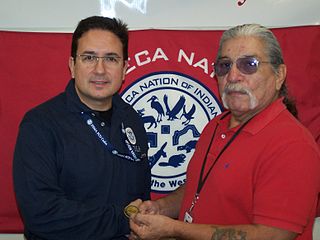Related Research Articles

The Allegheny River is a 325-mile-long (523 km) tributary of the Ohio River that is located in western Pennsylvania and New York in the United States. It runs from its headwaters just below the middle of Pennsylvania's northern border, northwesterly into New York, then in a zigzag southwesterly across the border and through Western Pennsylvania to join the Monongahela River at the Forks of the Ohio at Point State Park in Downtown Pittsburgh, Pennsylvania.

Cattaraugus County is a county in Western New York, with one side bordering Pennsylvania. As of the United States 2020 census, the population was 77,042. The county seat is Little Valley. The county was created in 1808 and later organized in 1817. The county is part of the Western New York region of the state.
Coldspring is a town in Cattaraugus County, New York, United States. As of the 2020 census it had a population of 661. It is located in the southwest part of the county, west of the city of Salamanca.
Red House is a town in Cattaraugus County, New York, United States. As of the 2020 census, the town population was 30, making it the least populous town in the state. The town is on the south edge of Cattaraugus County, south of the city of Salamanca.
South Valley is a town in Cattaraugus County, New York, United States. The population was 250 at the 2020 census. The name is derived from the town's geographical attributes.

Allegany Reservation is a Seneca Nation of Indians reservation in Cattaraugus County, New York, U.S. In the 2000 census, 58 percent of the population within the reservation boundaries were Native Americans. Some 42% were European Americans; they occupy properties under leases from the Seneca Nation, a federally recognized tribe. The population outside of the rented towns was 1,020 at the 2010 census. The reservation's Native American residents are primarily members of the Seneca, but a smaller number of Cayuga, another Iroquois nation, also reside there, and at least one family is known to have descended from the Neutral Nation. Prior to the 17th century, this area was occupied by the Iroquoian-speaking Wenrohronon and Eriehronon. The more powerful Seneca eliminated these competing groups during the Beaver Wars beginning in 1638, as the Iroquois Confederacy sought to control the lucrative fur trade with the French and Dutch colonists.
Salamanca is a town in Cattaraugus County, New York, United States. The population was 470 at the 2020 census. The name is from José de Salamanca y Mayol, Marquis of Salamanca, a major Spanish investor in the Atlantic and Great Western Railroad, a local railroad.
Salamanca is a city in Cattaraugus County, New York, United States, inside the Allegany Indian Reservation, one of two governed by the Seneca Nation of New York. The population was 5,929 at the 2020 census. It was named after José de Salamanca, a Spanish nobleman and cabinet minister of the mid-19th century. Salamanca invested in railroads around the globe, including the Atlantic and Great Western Railroad in New York State, Pennsylvania, and Ohio.

Allegany State Park is a state park in western New York State, located in Cattaraugus County just north of the Allegheny National Forest in Pennsylvania. The park is divided into two sections: The Red House Area and the Quaker Run Area. It lies within the Allegheny Highlands forests ecoregion.

The Kinzua Dam, on the Allegheny River in Warren County, Pennsylvania, is one of the largest dams in the United States east of the Mississippi River. It is located within the Allegheny National Forest.

New York State Route 280 (NY 280) is an 11.59-mile (18.65 km) long north–south state highway in rural Cattaraugus County, New York, in the United States. The southern terminus of the route is at the Pennsylvania state line in South Valley, where it becomes Pennsylvania Route 346 (PA 346). The northern terminus is at exit 18 on the Southern Tier Expressway in Coldspring, west of Salamanca. NY 280 follows both the eastern edge of the Allegheny Reservoir and the western boundary of Allegany State Park for its entire length.

New York State Route 417 (NY 417) is an east–west state highway located in the Southern Tier of New York in the United States. It begins at exit 20 of the Southern Tier Expressway in the city of Salamanca and ends at a junction with NY 415 in Painted Post, west of the city of Corning. At 105.25 miles (169.38 km) in length, NY 417 is the longest of the state highways that were formerly part of NY 17 before the construction of the Southern Tier Expressway. It also diverges the most from the current NY 17, coming within 100 feet (30 m) of the Pennsylvania state line at one intersection.

The Allegheny Reservoir is a reservoir along the Allegheny River in Pennsylvania and New York, USA. It was created in 1965 by the construction of the Kinzua Dam along the river. Lake Perfidy comes from Peter La Farge's ballad "As Long as the Grass Shall Grow," recorded by Johnny Cash on his album Bitter Tears: Ballads of the American Indian, which alleged that the reservoir's existence violates the 1794 agreement between Seneca chief Cornplanter and George Washington.

New York State Route 382 (NY 382) was a state highway in the town of Red House in Cattaraugus County, New York, in the United States. The highway was 0.8 miles (1.3 km) long and served as a connector between NY 17 and the Red House entrance of Allegany State Park, where it connected to Allegany State Park Route 2. NY 382 was assigned in the early 1930s and removed in the early 1970s after the highway's connection to the park was dismantled, and the hamlet it served evacuated, as part of the Southern Tier Expressway's construction. The NY 382 designation is currently reserved by the New York State Department of Transportation as a replacement for NY 88 in Ontario and Wayne counties.
The Ray Evans Seneca Theater is a stage theater located in the city of Salamanca, New York at the corner of Broad Street and Main Street in the center of the city. The theater is named after Ray Evans, a songwriter who was born and raised in Salamanca.
Steamburg is a hamlet in the Town of Coldspring in Cattaraugus County, in western New York, United States.

The Seneca Nation of Indians is a federally recognized Seneca tribe based in western New York. They are one of three federally recognized Seneca entities in the United States, the others being the Tonawanda Band of Seneca and the Seneca-Cayuga Nation of Oklahoma. Some Seneca also live with other Iroquois peoples on the Six Nations of the Grand River in Ontario.
Maxine Crouse Dowler was a teacher, Federal program administrator, member of the Board of Directors of the Seneca Nation Educational Foundation, member of the school board of the Salamanca, New York City Central School District that provides educational services to Seneca and other native American children residing on or near the Allegany Reservation of the Seneca Nation of Indians, Dowler was the first Seneca member of the Board of Education of the Cattaraugus-Allegany BOCES.
George D. Heron was president of the Seneca Nation of Indians from 1958 to 1960 and again from 1962 to 1964. In addition to his cultural and community work, he is known as a leader of the Seneca opposition to Kinzua Dam, and for his work organizing the tribal resettlement.
Elko was a town in Cattaraugus County, New York that existed from 1890 to 1965. It was forcibly evacuated in 1965 due to the construction of the Kinzua Dam on the Allegheny River in Warren County, Pennsylvania, one of the largest dams in the United States east of the Mississippi. The dam was authorized by the United States Congress as a flood control measure in the Flood Control Acts of 1936 and 1938, and was built by the U. S. Army Corps of Engineers beginning in 1960. Other benefits from the dam include drought control, hydroelectric power production, and recreation.
References
- ↑ Congdon, Charles (1968). Allegany Oxbow: A history of Allegany State Park and the Allegany Reserve of the Seneca Nation. Salamanca Area Museum Association.
- 1 2 Bilharz (2002), Allegany Senecas and Kinzua Dam, p. 111
- ↑ Miller, Rick (December 1, 2023). "Removal, replacement of Red House Bridge is underway". Olean Times Herald. Retrieved January 24, 2024.
